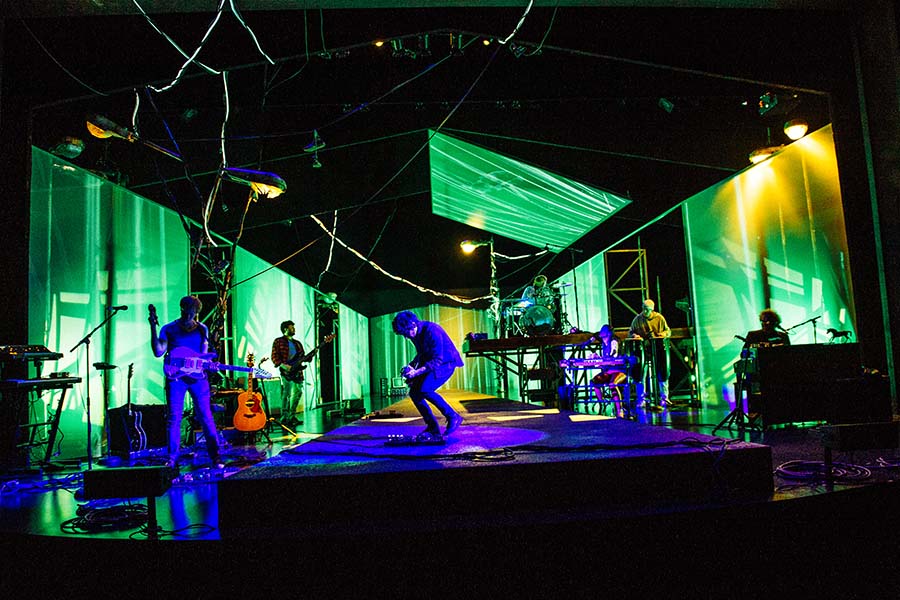On a November afternoon in a skylight-lit rehearsal room in Portland, Ore., the rock band Blitzen Trapper was puzzling through some chords. Frontman Eric Earley, who plays guitar, sings, and writes most of the group’s songs, turned and mumbled a few words to his four bandmates. At one point, he joined keyboardist Marty Marquis by the piano and plinked out a few notes by way of explanation.
Earley started the song over. Cut it off. Mumbled some more words. Restart. Cut. Mumble. Restart.
Liam Kaas-Lentz crouched at a table facing the band and shook his head in awe. “The shorthand these musicians have is just insane,” he whispered. “How do you direct a band rehearsal?”
How, indeed? That was the paramount question as Blitzen Trapper—an Oregon-born band that’s peddled its tight, hooky roots rock since the early aughts—prepared to mount Wild and Reckless, a world-premiere “concert event” that ran March 16-April 30, 2017, at Portland Center Stage, the city’s largest theatre company. How would a rock band—most of whose members had diddly theatre experience, and thus zero practice with blocking, precisely timed lighting cues, or sound effects operated from somewhere offstage—build a show for an audience accustomed to things like plot and character, not psychedelia-tinged guitar riffs?
At this early point, four months before opening, the answer to that question remained unclear—to both Blitzen Trapper and the show’s co-directors, Kaas-Lentz and Rose Riordan. Even so, as band members chatted before rehearsal, they seemed relaxed about the magnitude of the task. A nearly 20-year remove from their scrappy beginnings seemed to have granted them an easy confidence.
“When we started the band, we used to work at the crappiest places possible,” admitted Marquis, the keyboardist. “We never made any money, never played for anybody. There’s this weird feeling of transcending our past, because we’re now in this super-fancy place telling a story about those days.”
Bassist Michael Van Pelt interjected: “And people asked us to do it!”
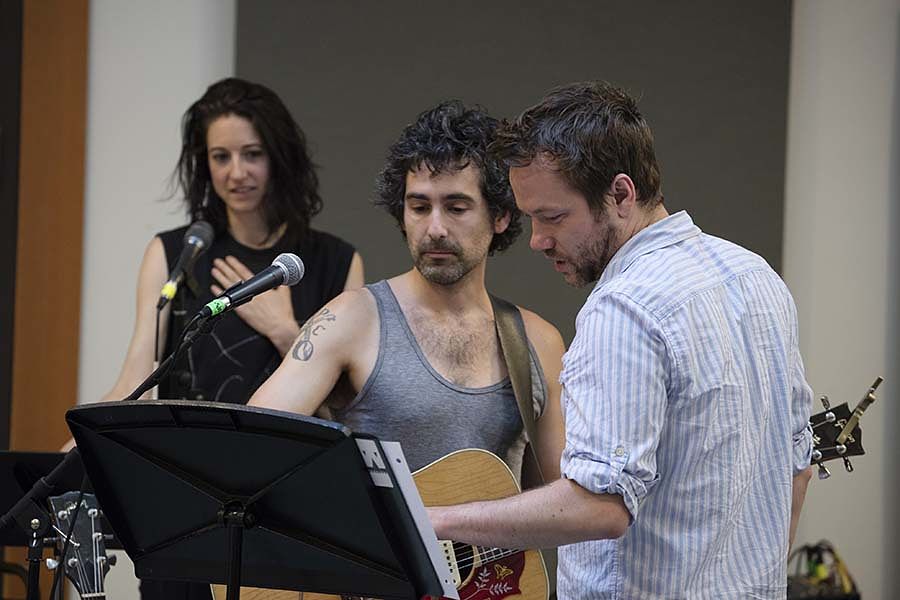
Rewind to early 2016, as the PCS leadership team was planning the theatre’s upcoming season. They’d already discussed a commission from writer and actor Lauren Weedman for a solo show with musical leanings of its own. But they wanted to book something to run in repertory so the Los Angeles-based Weedman didn’t have to churn through eight mainstage performances a week.
Kaas-Lentz—the theatre’s production manager, who would later marvel at Blitzen Trapper’s minimalist communication style—spoke up. He’d met Blitzen Trapper drummer Brian Adrian Koch in an acting class at Portland State University more than 10 years ago, and the two had remained friends, and occasional artistic collaborators, ever since. (Koch is the only band member with bona fide theatre experience: He’s acted in plays and on television, including “Portlandia” and “Grimm,” and he once put on a live stage adaptation of the infamous cult horror movie Manos: The Hands of Fate.)
“I went to Eric and Brian and asked if there was any chance Blitzen Trapper was sitting on an evening of musical narrative,” Kaas-Lentz says. “And they were like, ‘Yeah, we kinda are.’”
Bingo—kinda, anyway. It wasn’t all that surprising: Earley is a prolific songwriter, and a gothic, Old West sensibility fuels much of the band’s catalog. Consider the haunting murder ballad “Black River Killer,” which opens with a description of a dead girl abandoned in a pit by the Sunset Strip. The new musical narrative the band had in mind was a Romeo and Juliet-meets-Bonnie and Clyde story. Initially meant to be the backbone for Blitzen Trapper’s next album, the band’s ninth, Earley reckoned that with some tweaking it could be something bigger. Something theatrical.
PCS leadership was game. Artistic director Chris Coleman hadn’t heard of Blitzen Trapper—he claims to be clueless to any music made after the heyday of Bruce Springsteen and Fleetwood Mac—but found himself “super impressed with the quality of the musicianship and the complexity and depth of the lyrics.” In 2009, Coleman had worked with Portland rocker Storm Large to develop a solo show, Crazy Enough, for PCS. “This wasn’t wholly dissimilar,” he said. “It’s building a relationship with an artist who already has their own body of work and their own following, and figuring out what they can do in a theatrical format. It’s asking an artist who’s really skillful in one way of telling a story to explore something really outside of their zone.”
The Blitzen Trapper commission also fit within PCS’s new “Northwest Stories” series, shows about or by people from the region. Wild and Reckless would join a season that included Bekah Brunstetter’s The Oregon Trail and the first half of Astoria, a two-part epic about the history of that coastal city.
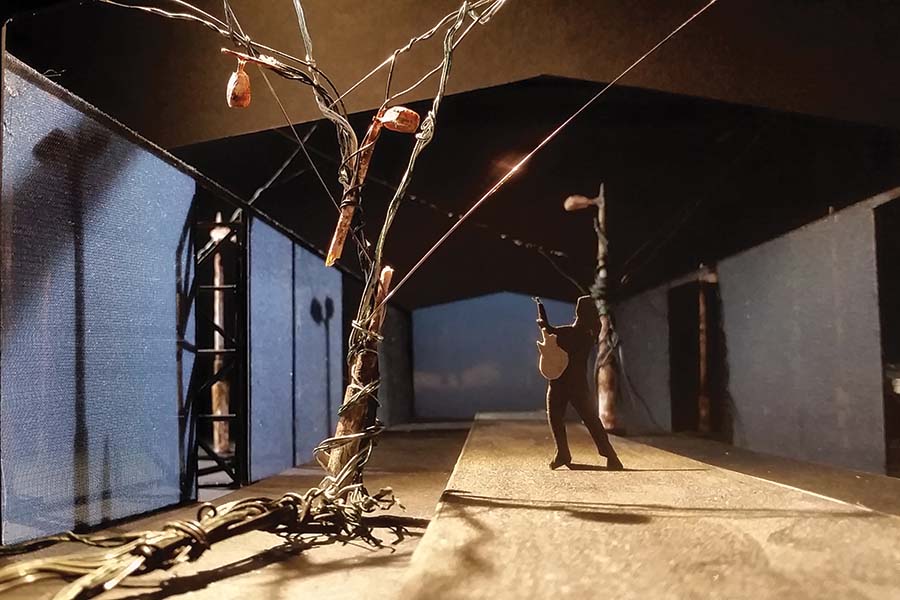
Earley wrote Wild and Reckless as an ill-fated love story based on his experiences in Portland in the early 2000s and his own long, thorny relationship with a heroin addict (Earley’s never been a user himself). But rather than setting the show in some grungy, pre-gentrification Portland, Earley imagined a futuristic, dystopian vision of the city’s past, where lightning is harvested for power by machines called “reapers.” The process produces a fine white dust that settles over everything, which people quickly realize is an extremely potent, extremely addictive opioid—an obvious stand-in for heroin. Users of this “lightning dust”—injected with a steampunk-style syringe—become more susceptible to lightning strikes, which leave them with permanent, fernlike scarring.
Even without the sci-fi dressing, it was a lot for one story to hold: star-crossed romance, body-ravaging addiction, heartless resource extraction. (This last theme has its autobiographical elements as well: Four of Blitzen Trapper’s members grew up in Salem, Oregon’s capital, where they witnessed firsthand the decline of the state’s timber industry.) And Earley’s first draft was, well, a little unwieldy.
“It was so huge and epic,” Koch recalled. “It was like a rock ’n’ roll Greek tragedy. Imagine a full chorus and dancers and choreography. It was larger than life. And then PCS was like: Let’s talk about Planet Earth.”
That conversation began in July 2016 at JAW, PCS’s annual playwriting festival. Blitzen Trapper put in two intensive weeks of workshopping with co-directors Kaas-Lentz and Riordan, shaping the material Earley had already written into something tighter—they scrapped the giant chorus and elaborately choreographed numbers, as well as an entire second act—but also attuned to the demands of the 590-seat auditorium where the band would be performing.
“For the most part, all of the songs were there, and they started falling into place,” Earley said. “I’d been tweaking lyrics here and there, and some things were pulled apart. But it wasn’t hard to use these songs to tell the story, or give it a punch if it needed anything.”
From the beginning, Earley impressed Kaas-Lentz and Riordan in the rehearsal room. “He walks in with the ideas, but he’s an amazing student,” Riordan said. “Even though he has no theatre experience, he has really good awareness about what works and what doesn’t.”
The JAW process clarified to Kaas-Lentz and Riordan that music needed to power the entire show—there would be no extended dialogue or exposition between songs. It would be billed as a “concert event” rather than as a musical, and staging would be simple. “It’s not going to be American Idiot, where everyone’s running around scaffolding,” Kaas-Lentz said.
In the narrative that solidified, Earley—identified in the script simply as “the Narrator”—is a small-town kid who moves from rural Oregon to Portland and falls in love with “the Girl.” But she’s addicted to the lightning dust, setting in motion a series of events that sends the two on a road trip through a post-apocalyptic wasteland of electric storms, burnt-out barns, and energy-hungry reapers. Earley said he liked to think of it as a real-life story refracted through a fantastical lens, and injected with a hit of sociopolitical commentary. “The lightning harvesting is power—it’s what America is all about,” he said. “We’re all about harvesting power from natural resources, but in the end it really only generates these destructive urges.”
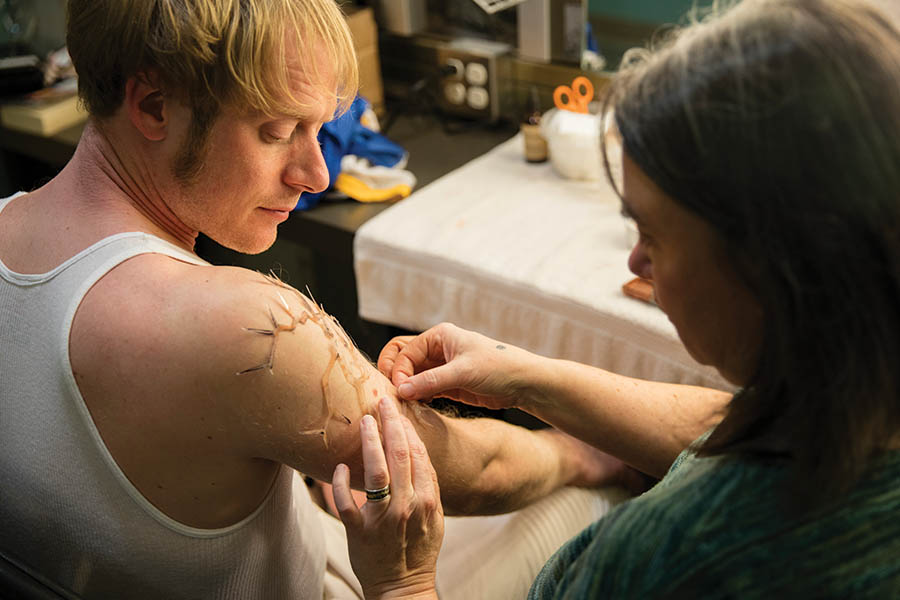
In February 2017, proper rehearsals kicked into gear. By this point, the bit parts played by the rest of the band members—aside from bassist Van Pelt, who would just do his string-plucking thing—had come into focus. Koch would play the Scientist, helping to explain the technology of this futuristic world (while also allowing him the chance to gleefully chomp some scenery). As the Professor, Marquis would provide sociological theorizing about addiction. Guitarist Erik Menteer would be the Kid, a childhood friend of the Girl who also winds up on the dust. Two professional actors would round out the cast: New York City-based Laura Carbonell as the Girl, and local favorite Leif Norby as the Dealer.
The cast began with two weeks in the theatre’s upstairs rehearsal room, where Earley’s inexperience with blocking sometimes collided with the show’s musical demands. One afternoon, he and Carbonell rehearsed a key scene: Their characters have just met and are now out together at the legendary, much-mourned Portland punk club Satyricon. “I’m in love with your mystery, with your every little move, so won’t you dance with me before the lights go down for good,” yowled Earley, who has a twangy voice and often sings (and speaks) out of the left side of his mouth. Strumming his guitar, he glided over to Carbonell at the keys—then had to scurry back to hit an effects pedal, draining the moment of any chemistry.
“A love story between a man and his pedals,” sighed Kaas-Lentz.
As the band buckled down in the rehearsal room, the rest of the creative team got to work. Scenic designer Sibyl Wickersheimer opted to keep the set simple and the stage fairly empty, because Wild and Reckless would be running in rep, as planned, with Weedman’s solo show, Lauren Weedman Doesn’t Live Here Anymore. That approach would also accommodate changes to the script or story, which were likely with a set of brand-new shows in the works.
One scenic element, however, was mandatory: the reapers, those energy-harnessing lightning rods. Through conversation with Earley, Wickersheimer came to envision the reapers as flickering, rusted streetlamps, wrapped in a tangle of cords. Those cords were more than just an aesthetic choice. They played a practical role, jibing nicely with—and even bringing some logic to—the mess of audio cables Blitzen Trapper needed onstage. Wickersheimer also strung white neon rope lights above the stage, ready to pulse at the moment of a lightning strike.
Video projections on six large panels flanking the stage would further establish this world—both specific Portland locations and more abstract, psychic spaces. PCS brought in Jared Mezzocchi, a highly regarded young multimedia artist (he was the first projection designer to win a Princess Grace Award). As a first step, Mezzocchi compiled representational footage: loops of Portland streets and bridges, for example. He uses software that allows for real-time rendering, meaning he can manipulate imagery on the spot during rehearsal.
“When Rose was like, ‘I wish it were raining,’ I could immediately make it rain,” Mezzocchi said. “When I’m working live, the pressure’s out the window, so people can be like, ‘Uhhh, that sucks.’ We toss preciousness out, knowing that it’s going to be messy until it’s not.”
Some of the messiness came from nailing the Portland landmarks called out in the story, including Satyricon’s graffiti-shrouded exterior and a karaoke dive called Chopsticks (there was a minor flap during rehearsal when the wrong Chopsticks location flashed on the screen; Mezzocchi quickly remedied the mistake). Mezzocchi fuzzed out some of the more obvious references and added plenty of atmospheric footage to strike the right balance of grit and sci-fi: tube television static, dense gray clouds, train tracks, a time lapse of highway traffic, bouncing orbs of light.
The goal was a blighted but surreal vision of Portland. From the beginning, Earley made clear he didn’t intend to glorify the city’s past, but it was inevitable the show would stir up some nostalgia, in part because Portland has seen such dramatic change over the last decade. A bit of flannel and karaoke aside, the Portland of Wild and Reckless was not to be the Portland of “Portlandia.” The young people of Wild and Reckless had not come here to retire—and definitely not to launch artisan pickling enterprises.
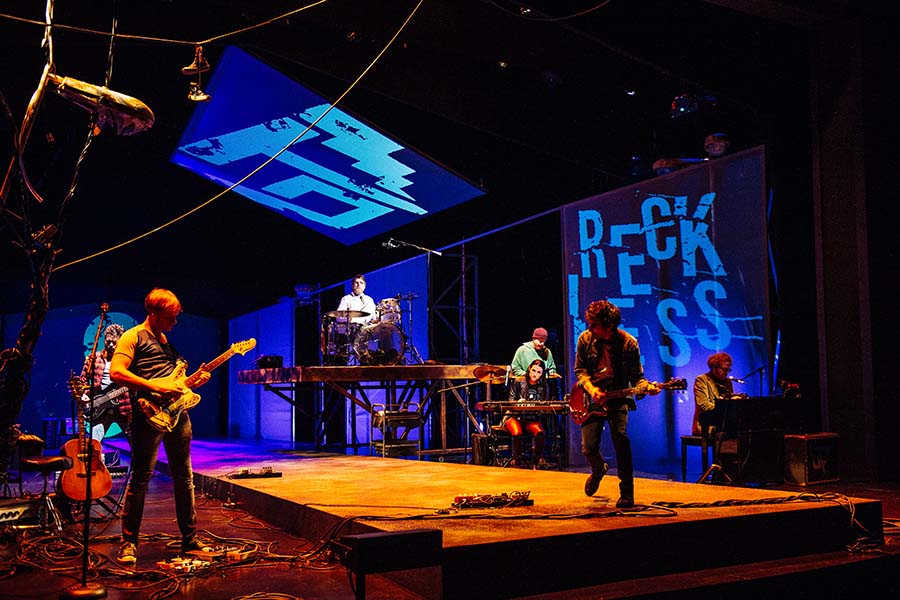
The show opened March 24 to a not-quite-full house. Marquis, playing a few notes on the piano, welcomed the crowd: “If you’re accustomed to going to rock shows, welcome to a night at the theatre. If you’re a theatregoer, this may resemble a rock concert.”
Those words, which Riordan called the show’s “single most important line,” came about after the first preview, when PCS literary manager Benjamin Fainstein found himself in the balcony with a group of Blitzen Trapper fans. They were bobbing their heads and bopping in their seats—standard concert behavior, in other words. But it seemed to startle some volunteer ushers seated nearby. “Ben told us we should call it out—that we should put a point on it,” Kaas-Lentz said.
Riordan went on: “Marty’s line gives everything for context and setup. People expecting a musical aren’t struggling, and neither are concertgoers. Everybody has permission to engage.”
Despite that welcoming line, critical reception was mixed. The performers earned widespread praise for their musical prowess. Lee Williams of The Oregonian applauded “Earley’s true-to-life storytelling and gifted musicianship,” while Oregon Arts Watch’s A.L. Adams commended the show for going beyond “cheeseball pantomimes of instrument playing” to “real rocking out, complete with psychedelic, pedal-heavy space-outs, shredding guitar solos, and spine-tingling harmonies of quiet, distant ‘oohs.’” In a radio review, Aaron Scott and Jerad Walker of Oregon Public Broadcasting described Blitzen Trapper as “one of the tightest rock bands in town,” and went on to call the show “a great piece of over-the-top rock-opera music.”
Each of these critics, however, quibbled with other aspects of the production. Scott and Walker came down the hardest, expressing frustration that “characters are reduced to single facets.” Though the audience “ate up” the Portland references—on opening night, even mention of a local detox center earned shrieks of recognition—Scott found them a crutch. “Instead of developing these characters into people that you really cared about and a storyline that had some surprises or something unexpected,” he said, “it relied on our Portland affinity to create any sort of connection between the story and the audience.”
Adams likewise yearned for more character development, noting a stark divide between the band members’ low-key performances and the stagier approaches of Carbonell and Norby, the cast’s two professional actors. “As the show goes on, the incongruities between the understated band members and the overexuberant actors begin to grate,” she wrote. “The Girl and the Dealer are all sparkle and no black hole.”
For his part, Williams, while largely positive about Earley and Carbonell’s “chemical romance” and the show’s “incredible soundscape,” didn’t dig the story’s “weird electrostatic science,” calling it “a murky sci-fi stew that never quite gels.”
From the inside, though, the cast and creative team were grateful to PCS for undertaking the experiment.
“What’s so cool is that it’s a marriage of two totally different art forms,” Earley said. “It’s this low-high thing. The more I get involved in it, the more it seems like the future of rock music and the future of theatre need to be intertwined in some way. It seems like theatres should be open to these kinds of opportunities for bands who have this sort of long play in mind.” He paused. “Who wouldn’t want to see My Morning Jacket do a play?”
Consider the gauntlet thrown.

